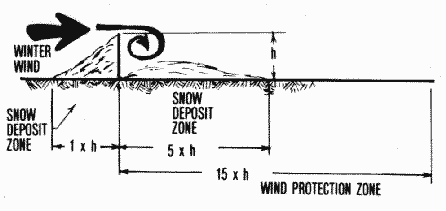
AE-102

The cold, strong winds and large snowfalls of recent Midwest winters have caused many farm families to re-evaluate the need for "controlling' these energy-wasting disturbances.
There are no foolproof methods of wind and snow control, since the amounts of precipitation and the wind speed and direction constantly change. However, a protective system based on prevailing winter winds and average snowfall frequencies can significantly minimize their severity and effects on a farming operation. And the benefits of these improvements may well be realized year `round.
This publication discusses briefly the principles of wind and snow control, then examines the types of control systems that might be used around the farmstead. Finally, it provides planning guidelines for minimizing wind and snow problems.
The following basic principles of control will help us understand the reasons for taking certain approaches to wind and snow problems:
As we discuss the problems of wind and snow control, bear in mind that these principles apply to all objects that will slow the velocity and/or change the direction of the wind. Such objects include windbreaks, snow fences, farm buildings, silos, trees and shrubs, shelterbelts, terrain surfaces and configurations, etc. What we can do to control the velocity and direction of wind will usually also control snow, because wind-driven snow causes drifting snow.
There are various systems for changing wind direction and reducing its velocity to control wind and snow. We will consider them individually, pointing out how each works and why, and where it would likely be most effective.
Solid Fences
As wind slams into a solid fence, it is either forced up and over the obstacle or around it. Air pressure increases on the upwind (windward) side, and a slight vacuum is created on the downwind (leeward) side. As the wind is forced over the top of this solid barrier, its velocity increases. After crossing the top of the barrier, the vacuum created on the downwind side causes air turbulence which dissipates the wind's energy. The wind no longer retains enough energy and velocity to carry a snow load; therefore, the snow drops out.
Wind drops the snow in two places: (1) on the upwind side of the fence at a 45-degree angle for a distance of about one-fence-height, and (2) on the downwind side for a distance equal to about five times the fence height (Figure 1). The distance of snow-drop on the downwind side is not directly proportional to fence height, and the effect is somewhat less than five times the height for very high fences. The area of wind and snow protection for a solid fence, then, extends from about five to fifteen times the fence height downwind.

A solid windbreak is usually built adjacent to the area it is designed to protect, since snow accumulation does not usually extend out far from the fence. It is most commonly used to block or divert wind away from a livestock feedlot.
Windbreak fences require sturdy construction,